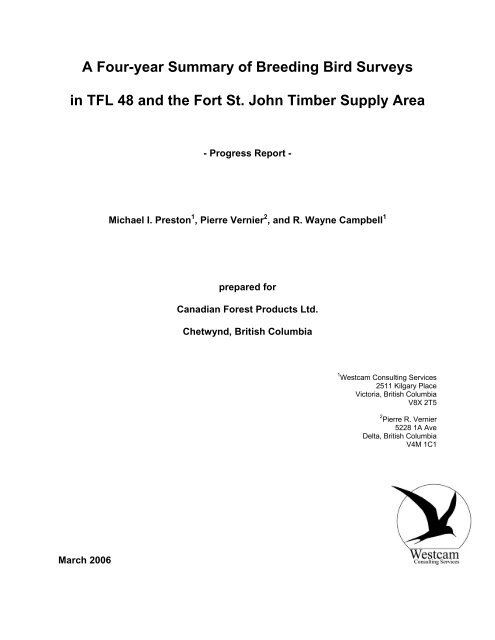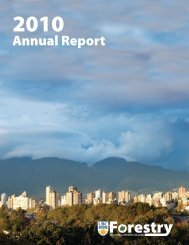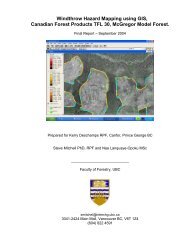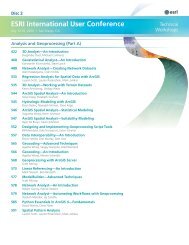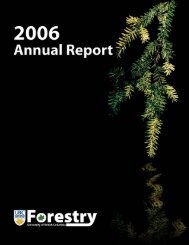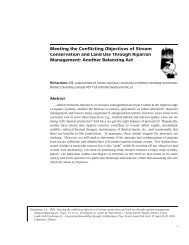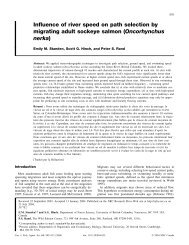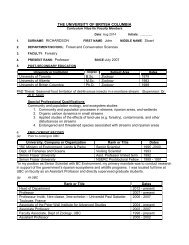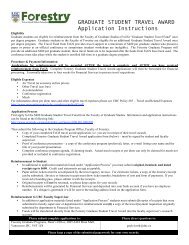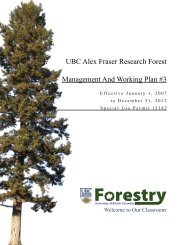A Four-year Summary of Breeding Bird Surveys in TFL 48 ... - BIOD
A Four-year Summary of Breeding Bird Surveys in TFL 48 ... - BIOD
A Four-year Summary of Breeding Bird Surveys in TFL 48 ... - BIOD
You also want an ePaper? Increase the reach of your titles
YUMPU automatically turns print PDFs into web optimized ePapers that Google loves.
Table <strong>of</strong> ContentsEXECUTIVE SUMMARY................................................................................................. 1INTRODUCTION............................................................................................................. 1STUDY AREA & METHODS ........................................................................................... 3Coverage...................................................................................................................... 5Survey Dates................................................................................................................ 6RESULTS........................................................................................................................ 6Species Richness, Abundance, and Diversity .............................................................. 6Prelim<strong>in</strong>ary Trends ..................................................................................................... 17Species List<strong>in</strong>gs: Committee on the Status <strong>of</strong> Endangered Wildlife <strong>in</strong> Canada,and the British Columbia M<strong>in</strong>istry <strong>of</strong> Susta<strong>in</strong>able Resource Management ................. 21DISCUSSION and RECOMMENDATIONS................................................................... 23Coverage.................................................................................................................... 23The Peace River District: Then and Now ................................................................... 23Conclud<strong>in</strong>g Remarks.................................................................................................. 26LITERATURE CITED .................................................................................................... 28ACKNOWLEDGEMENTS ............................................................................................. 30APPENDICES ............................................................................................................... 31Appendix 1. List <strong>of</strong> species names, correspond<strong>in</strong>g codes, scientific names,and presence or absence <strong>in</strong> <strong>TFL</strong> <strong>48</strong> and the Fort St. John TSA (FSJ)....................... 31Appendix 2. <strong>Summary</strong> <strong>of</strong> mean (± SE) species richness, bird abundance,and diversity for each route ........................................................................................ 34
irds, per transect, respectively. We attribute these differences to our concentratedsampl<strong>in</strong>g effort <strong>of</strong> primarily forested habitats, compared to historical surveys that weregenerally <strong>in</strong> low-ly<strong>in</strong>g rural areas with greater habitat heterogeneity. The precise location<strong>of</strong> 1,070 bird survey stations was recorded us<strong>in</strong>g a Global Position<strong>in</strong>g System (GPS).No species listed by the Committee on the Status <strong>of</strong> Endangered Wildlife <strong>in</strong>Canada were observed dur<strong>in</strong>g surveys. There were two observations <strong>of</strong> the BayBreasted-Warbler, a "Red-listed" species <strong>in</strong> British Columbia (British Columbia M<strong>in</strong>istry<strong>of</strong> Environment, BC Species and Ecosystems Explorer). There were severalobservations <strong>of</strong> "Blue-listed" species that <strong>in</strong>cluded the Black-throated Green Warbler (n= 31), Canada Warbler (n = 3), Philadelphia Vireo (n = 7), and LeConte's Sparrow (n =2).2
INTRODUCTIONWe began establish<strong>in</strong>g <strong>Breed<strong>in</strong>g</strong> <strong>Bird</strong> <strong>Surveys</strong> (BBS) <strong>in</strong> Tree Farm License (<strong>TFL</strong>)<strong>48</strong> <strong>of</strong> the Peace River District <strong>in</strong> the summer <strong>of</strong> 2002 to evaluate the response <strong>of</strong>various bird species to different seral stages and structural classes <strong>in</strong> a managed forest,and to assess species richness, abundance, and diversity, as well as habitat use, <strong>of</strong>birds. From 2003 to 2004, new routes were gradually added to <strong>TFL</strong> <strong>48</strong> to <strong>in</strong>creasehabitat representation over the tenure. In 2005 the monitor<strong>in</strong>g program was expandedto <strong>in</strong>clude the Fort St. John Timber Supply Area (TSA) for the same purpose as <strong>TFL</strong> <strong>48</strong>.<strong>Breed<strong>in</strong>g</strong> <strong>Bird</strong> <strong>Surveys</strong> (BBS) have long been used as a method for obta<strong>in</strong><strong>in</strong>g a relative<strong>in</strong>dex <strong>of</strong> species abundance and population change (Robb<strong>in</strong>s et al. 1986). However, nolarge-scale systematic surveys <strong>of</strong> summer birds have previously been conducted <strong>in</strong>either <strong>TFL</strong> <strong>48</strong> or the Fort St. John TSA.The benefits <strong>of</strong> BBS data are two-fold. In the short term, <strong>in</strong>dices <strong>of</strong> variation <strong>in</strong>the distribution and abundance <strong>of</strong> <strong>in</strong>dividual species can be mapped and associatedwith changes <strong>in</strong> present-<strong>year</strong> climatic conditions and differences <strong>in</strong> habitat. In the longterm, species' population trends and changes <strong>in</strong> distribution can be assessed regionallyand associated with habitat alteration, large-scale climatic patterns, and historicalspecies’ distributions. Subsequently, species-habitat associations can be used to modelpredicted changes <strong>in</strong> habitat suitability and use based on forest harvest<strong>in</strong>g practices.Variation <strong>in</strong> the spatial scale at which BBS data can be applied is also animportant component. Individual survey stations can elicit direct results <strong>of</strong> habitatchange, whereas transects as a whole can provide <strong>in</strong>formation regard<strong>in</strong>g broaderchanges that may occur at the scale <strong>of</strong> watersheds or landscapes (Bender et al. 1998;1
Newton 1998; Robb<strong>in</strong>s 1978). The analysis <strong>of</strong> several transects may provide<strong>in</strong>formation about changes that occur at larger scales, or may be used comparatively todemonstrate regional variation <strong>in</strong> species' distributions and abundance.The latest large-scale report on BBS <strong>in</strong> North America spanned the period 1965to 1979 (Robb<strong>in</strong>s et al. 1986). In that report, the whole <strong>of</strong> North America was assessed,with broad generalizations about major physiographic regions. Predictions <strong>of</strong> speciesrichness, abundance, and diversity were thus extrapolated for <strong>TFL</strong> <strong>48</strong>, even though nospecific data for most <strong>of</strong> the region was available. More current assessments <strong>of</strong> these<strong>in</strong>dices are available on the World Wide Web, but estimates are typically derived from“easy-driv<strong>in</strong>g roads” rather than <strong>in</strong>dustry-based forestry roads. Consequently, managedforests are severely under-represented.The purpose <strong>of</strong> this report is to provide a summary <strong>of</strong> bird species richness,abundance and diversity for each transect, as well as for each major region (i.e., <strong>TFL</strong> <strong>48</strong>and Fort St. John TSA), and to make recommendations for future research as it appliesto the management and mitigation <strong>of</strong> birds <strong>in</strong> a large managed forest landscape. Trend<strong>in</strong>formation is provided for some species, but should be considered <strong>in</strong>adequate fordraw<strong>in</strong>g broad conclusions about the direction <strong>of</strong> species' populations. Instead, thetrends provide a visual estimate <strong>of</strong> annual variation for the Peace River District.Identification <strong>of</strong> COSEWIC (Committee on the Status <strong>of</strong> Endangered Wildlife <strong>in</strong> Canada,2002) or BCMoE (British Columbia M<strong>in</strong>istry <strong>of</strong> Environment) listed species, habitatrepresentation, and other f<strong>in</strong>d<strong>in</strong>gs considered important to species-habitat relationshipsare discussed. Related publications that provide modelled estimates <strong>of</strong> species-habitat2
associations, as well as BEC subzone preference, are provided by Vernier (2005) andVernier and Bunnell (In press).STUDY AREA & METHODSMethodology for the <strong>Breed<strong>in</strong>g</strong> <strong>Bird</strong> Survey (BBS) was adapted from Sen (1981)and Bystrak (1981) and further modified to <strong>in</strong>clude habitat, weather, and noise-relatedvariables for each survey station. Each BBS transect but two (Wolver<strong>in</strong>e = 25, Sikanni =45) had 50 survey stations, spaced approximately 800 m apart. Dur<strong>in</strong>g surveys, twotransects (Gwillim = 25, Haystack = 44) were shortened for logistic reasons. <strong>Surveys</strong>commenced at sunrise and generally lasted four to five hours. Each survey station wassurveyed for three m<strong>in</strong>utes, with all birds seen and heard recorded. Transects weredesigned to cover as much <strong>of</strong> the variation <strong>in</strong> forested habitats available <strong>in</strong> CanadianForest Products Ltd. lands <strong>of</strong> <strong>TFL</strong> <strong>48</strong> and the Fort St. John TSA. However, because <strong>of</strong>limited road access, variability <strong>in</strong> terra<strong>in</strong>, private lands, and gated roadways, transectscould not be assigned us<strong>in</strong>g a randomized procedure. Instead, transects wereassociated with logg<strong>in</strong>g roads that were suitable for summer access with a 4x4 vehicle.On some transects a few survey stations were situated on paved highways for thepurpose <strong>of</strong> sampl<strong>in</strong>g shorter logg<strong>in</strong>g roads, but ma<strong>in</strong>ta<strong>in</strong><strong>in</strong>g consistent sampl<strong>in</strong>g effort.Each observed bird was assigned to one <strong>of</strong> two distance classes:1) ≤ 50 m (for bird density calculations); and2) 51 – 200 m (as suggested by Bibby et al. (1992) for moderately dense forest withregular open<strong>in</strong>gs and relatively low canopy height).In addition to bird observations from each po<strong>in</strong>t, estimates <strong>of</strong> forest structure (i.e., standage, species composition, and understory), weather, and noise were also made. For the3
most part, stand structure was generalized, follow<strong>in</strong>g the system proposed by Campbell(1997). However, for all transects established <strong>in</strong> the Fort St. John TSA <strong>in</strong> 2005, werecorded more specific stand structure <strong>in</strong>formation.<strong>Bird</strong> species were recorded us<strong>in</strong>g standardized four-letter species codes forBritish Columbia (Preston et al. 2005, Appendix 1). Noise levels were expected tohamper the detection <strong>of</strong> some species or some <strong>in</strong>dividuals at a particular distance fromthe observer. Therefore, a measure <strong>of</strong> noise (i.e., a pass<strong>in</strong>g vehicle, cha<strong>in</strong>saw, flow<strong>in</strong>gwater, etc.) was recorded as either temporary, permanent or absent for each count (seeAppendix 2 for noise categories). Weather variables <strong>in</strong>cluded temperature, w<strong>in</strong>d speed,cloud cover, and precipitation. Temperature was recorded us<strong>in</strong>g an alum<strong>in</strong>iumarmouredpocket thermometer held <strong>in</strong> the shade and away from the vehicle for theduration <strong>of</strong> the count. W<strong>in</strong>d speed, cloud cover and precipitation were assigned to predef<strong>in</strong>edcategories, although no surveys were done <strong>in</strong> moderate to heavy ra<strong>in</strong> or w<strong>in</strong>d(see Appendix 2 for climate categories).Calculations <strong>of</strong> mean species richness, abundance, and diversity were primarilyused for demonstrat<strong>in</strong>g general patterns with<strong>in</strong> <strong>TFL</strong> <strong>48</strong> and the Fort St. John TSA.Generally, greater than eight <strong>year</strong>s <strong>of</strong> data are needed for the purpose <strong>of</strong> assess<strong>in</strong>gpopulation trends <strong>of</strong> various species and determ<strong>in</strong><strong>in</strong>g reasonable estimates <strong>of</strong> density(Robb<strong>in</strong>s et al. 1986). Fewer <strong>year</strong>s are needed to develop species-habitat modelsalthough additional <strong>year</strong>s could improve their robustness (Vernier 2005).Several maps were used to facilitate the establishment <strong>of</strong> transects, <strong>in</strong>clud<strong>in</strong>gCanadian Forest Products Ltd. maps, government maps, and Forest Service maps. In4
2005, a handheld Magellan GPS with MapSource greatly facilitated f<strong>in</strong>d<strong>in</strong>g andestablish<strong>in</strong>g transects <strong>in</strong> the Fort St. John TSA.A team <strong>of</strong> two people was used to survey the entire area each <strong>year</strong>. Generally,one person was responsible for coord<strong>in</strong>at<strong>in</strong>g effort, navigation, and data-record<strong>in</strong>g. Theother person was responsible for flagg<strong>in</strong>g po<strong>in</strong>ts and record<strong>in</strong>g habitat, weather, andnoise data. In all cases, transects were flagged several days before the survey. Thisensured that all survey stations were adequately marked, and that a complete transect<strong>of</strong> 50 survey stations was achievable for the area <strong>of</strong> <strong>in</strong>terest. In 2005, all survey stations<strong>in</strong> <strong>TFL</strong> <strong>48</strong> were re-flagged to ensure accuracy.Analysis <strong>of</strong> data was done us<strong>in</strong>g Micros<strong>of</strong>t Access Queries, SPSS version 12.0(SPSS Inc. 2003), and Ecological Methodology (Krebs 1999). Taxonomic names andfour-letter codes <strong>of</strong> species <strong>in</strong>cluded <strong>in</strong> this report are provided <strong>in</strong> Appendix 1.CoverageFrom 2002 – 2004, 15 transects yield<strong>in</strong>g 725 survey stations were established <strong>in</strong>the <strong>TFL</strong> <strong>48</strong>, from the southern edge <strong>of</strong> Williston Lake along Table Creek Forest ServiceRoad, south to Murray River near Tumbler Ridge. Among the survey stations, 539 were<strong>in</strong>side the <strong>TFL</strong> <strong>48</strong> boundary, 159 were outside but with<strong>in</strong> 5 km <strong>of</strong> the <strong>TFL</strong> <strong>48</strong> boundary,and 27 were > 5 km outside the <strong>TFL</strong> <strong>48</strong> boundary. In 2005, seven transects yield<strong>in</strong>g 345survey stations were established <strong>in</strong> the Fort St. John TSA, from the Alberta-BritishColumbia border <strong>in</strong> the east, to the Sikanni Chief River <strong>in</strong> the northwest.5
Survey Dates<strong>Surveys</strong> were conducted throughout June <strong>in</strong> all four <strong>year</strong>s so as to detect allresident birds that had returned from southern w<strong>in</strong>ter<strong>in</strong>g grounds, and to excludemigrants pass<strong>in</strong>g through the area <strong>in</strong> late May. In 2002 and 2004, surveys wereconducted <strong>in</strong> the latter half <strong>of</strong> June (13 – 29 June <strong>in</strong> 2002; 17 June – 1 July <strong>in</strong> 2004),whereas <strong>in</strong> 2003 and 2005, surveys were spread more evenly across the month (2 – 30June <strong>in</strong> 2003; 1 June – 1 July <strong>in</strong> 2005).RESULTSSpecies Richness, Abundance, and DiversityA total <strong>of</strong> 111 bird species were observed from all BBS transects between 2002and 2005. Among the <strong>TFL</strong> <strong>48</strong> transects, 109 species were observed, <strong>of</strong> which 72, 82,92, and 84 species were detected <strong>in</strong> 2002, 2003, 2004, and 2005, respectively. Fromfour <strong>year</strong>s <strong>of</strong> sampl<strong>in</strong>g <strong>in</strong> <strong>TFL</strong> <strong>48</strong>, 22 species comprised 80% <strong>of</strong> all bird detections. TheSwa<strong>in</strong>son's Thrush was the most frequently detected (Figure 1; n = 2,604 <strong>in</strong>dividuals).The White-throated Sparrow, which had fewer than half the detections <strong>of</strong> Swa<strong>in</strong>son'sThrush, was the second most frequently detected species with 1,142 <strong>in</strong>dividuals. Otherabundant species <strong>in</strong> <strong>TFL</strong> <strong>48</strong> <strong>in</strong>cluded P<strong>in</strong>e Sisk<strong>in</strong> (1,118), Warbl<strong>in</strong>g Vireo (1,036),Wilson's Warbler (982), and Chipp<strong>in</strong>g Sparrow (831). Among the Fort St. John TSAtransects surveyed <strong>in</strong> 2005, 66 species were detected. Of these, 13 species comprised80% <strong>of</strong> all detections. The Yellow-rumped Warbler was the most frequently detectedspecies with 270 <strong>in</strong>dividuals (Figure 2). Other species <strong>of</strong> <strong>in</strong>terest <strong>in</strong>clude Ruby-crownedK<strong>in</strong>glet (210), Chipp<strong>in</strong>g Sparrow (184), White-throated Sparrow (157), TennesseeWarbler (139), and Swa<strong>in</strong>son's Thrush (108).6
30002500Total Observations2000150010005000SpeciesTEWADEJUYRWACHSPWIWAWAVIPISIWTSPSWTHGRJAGCKILEFLYEWAVATHLISPALFLRCKIAMREOCWAAMROFigure 1. Frequency <strong>of</strong> detection for the 20 most common species from <strong>TFL</strong> <strong>48</strong>transects between 2002 and 2005.300250Total Observations200150100500RCKIYRWAWAVILISPSWTHTEWAWTSPCHSPSpeciesYBSAFOSPOCWAAMROPISIALFLHETHGRJADEJUFigure 2 Frequency <strong>of</strong> detection for the top 17 most common species from Fort St. JohnTSA transects <strong>in</strong> 2005.7
For transects surveyed only <strong>in</strong> 2005, mean species richness and abundancediffered between <strong>TFL</strong> <strong>48</strong> and the Fort St. John TSA. Mean species richness for thetransects <strong>in</strong> <strong>TFL</strong> <strong>48</strong> was 41.3, with a maximum <strong>of</strong> 52 from Willow-Fall<strong>in</strong>g Creek and am<strong>in</strong>imum <strong>of</strong> 26 from Upper Wolver<strong>in</strong>e. Mean bird abundance for the <strong>TFL</strong> <strong>48</strong> transectswas 340, with a maximum <strong>of</strong> 435 from Sukunka and a m<strong>in</strong>imum <strong>of</strong> 193 from UpperWolver<strong>in</strong>e. In the Fort St. John TSA, mean species richness for seven transects was32.6, with a maximum <strong>of</strong> 39 from Haystack (*only 44 stations were surveyed on thistransect) and a m<strong>in</strong>imum <strong>of</strong> 28 from Peejay 2. Mean bird abundance for the Fort St.John TSA transects was 280, with a maximum <strong>of</strong> 355 from Haystack and a m<strong>in</strong>imum <strong>of</strong>224 from Sikanni (only 45 stations were surveyed on this transect).Species diversity for the Fort St. John TSA transects was generally lower thanthose for <strong>TFL</strong> <strong>48</strong> transects, and ranged from 3.78 (Tommy Lakes 2) to 4.43 (Haystack).Diversity among the <strong>TFL</strong> <strong>48</strong> transects ranged from 4.00 (Upper Wolver<strong>in</strong>e) to 4.82(Willow-Fall<strong>in</strong>g Creek), which is greater than that previously reported by Preston andCampbell (2003). This difference is likely a result <strong>of</strong> sampl<strong>in</strong>g a broader range <strong>of</strong>forested habitats on more transects (e.g., 7 transects <strong>in</strong> 2002 versus 15 transects <strong>in</strong>2005), and variation among <strong>year</strong>s. A complete summary <strong>of</strong> species richness,abundance, and diversity for each transect is provided <strong>in</strong> Appendix 2.From 2002 – 2004, mean species richness (Figure 3), abundance (Figure 4), anddiversity (Figure 5) per transect <strong>in</strong> <strong>TFL</strong> <strong>48</strong> was variable, but <strong>in</strong>creas<strong>in</strong>g. In 2005,variability was similar to previous <strong>year</strong>s, but the average was lower, perhaps as a result<strong>of</strong> unseasonably wet conditions <strong>in</strong> that <strong>year</strong>. Both Gwillim (<strong>in</strong> 2005) and Wolver<strong>in</strong>econtribute more to the variability than other transects because <strong>of</strong> lower sample sizes.8
5250<strong>48</strong>Species Richness46444240382002 2003 2004 2005YearFigure 3. Mean species richness (± SE) for <strong>TFL</strong> <strong>48</strong> for each <strong>year</strong> surveyed (n = 7 for2002; n = 13 for 2003; n = 15 for 2004; n = 15 for 2005).500450Abundance4003503002002 2003 2004 2005YearFigure 4. Mean bird abundance (± SE) for <strong>TFL</strong> <strong>48</strong> for each <strong>year</strong> surveyed (n = 7 for2002; n = 13 for 2003; n = 15 for 2004; n = 15 for 2005).9
4.74.6Species Diversity (H')4.54.44.34.24.14.02002 2003 2004 2005YearFigure 5. Mean species diversity (± SE) for <strong>TFL</strong> <strong>48</strong> for each <strong>year</strong> surveyed (n = 7 for2002; n = 13 for 2003; n = 15 for 2004; n = 15 for 2005).10
For <strong>TFL</strong> <strong>48</strong>, mean rank abundance per survey station for the 20 most frequentlydetected species <strong>in</strong> 2003, 2004, and 2005 are shown <strong>in</strong> Figure 6. Swa<strong>in</strong>son's Thrushwas the only species to ma<strong>in</strong>ta<strong>in</strong> its rank as the most frequently detected species <strong>in</strong>each <strong>year</strong> <strong>in</strong> that region. The rema<strong>in</strong><strong>in</strong>g species' positions shifted gradually among<strong>year</strong>s. In the Fort St. John TSA, mean rank abundance per survey station for the 20most frequently detected species <strong>in</strong> 2005 is shown <strong>in</strong> Figure 7. The Yellow-rumpedWarbler was the most frequently detected species, compared to Swa<strong>in</strong>son's Thrush,which appeared <strong>in</strong> fifth position. Unlike <strong>in</strong> <strong>TFL</strong> <strong>48</strong>, Swa<strong>in</strong>son's Thrush <strong>in</strong> the Fort St.John TSA is expected to shift rank as evidenced by the overlapp<strong>in</strong>g variability with itsclosely rank<strong>in</strong>g neighbours.11
20031.501.25# <strong>Bird</strong>s / Station1.000.750.50OCWAWIWAYRWACHSPWAVIPISIWTSPSWTHVATHALFLGRJALEFLAMROYEWARCKIGCKILISPAMRE0.250.00DEJUTEWASpecies20041.501.25# <strong>Bird</strong>s / Station1.000.750.50OCWAWIWAYRWACHSPWAVIPISIWTSPSWTHVATHALFLGRJALEFLAMROYEWARCKIGCKILISPAMRE0.250.00DEJUTEWASpecies20051.501.25# <strong>Bird</strong>s / Station1.000.750.500.250.00DEJUTEWAOCWAWIWAYRWACHSPWAVIPISIWTSPSWTHSpeciesVATHALFLGRJALEFLAMROYEWARCKIGCKILISPAMREFigure 6. Mean (± SE) number <strong>of</strong> birds detected per station for 20 regularly occurr<strong>in</strong>gspecies <strong>in</strong> <strong>TFL</strong> <strong>48</strong> (2001-2005).12
1.000.80# <strong>Bird</strong>s / Station0.600.400.200.00-0.20RCKIYRWALISPSWTHTEWAWTSPCHSPPISIHETHGRJADEJUWAVIALFLOCWAFOSPAMROYBSASpeciesFigure 7. Mean (± SE) number <strong>of</strong> birds detected per station for 17 regularly occurr<strong>in</strong>gspecies on 7 transects surveyed <strong>in</strong> the Fort St. John TSA <strong>in</strong> 2005.13
Variation <strong>in</strong> abundance among transects with<strong>in</strong> a species is most likely attributedto differences <strong>in</strong> habitat quality and availability, whereas variation among <strong>year</strong>s isprobably attributable to other factors (e.g., climatic variation, annual fecundity). Forexample, among the first six transects that were established <strong>in</strong> 2002, the abundance <strong>of</strong>Swa<strong>in</strong>son's Thrush was usually greatest on the West Utah-Johnson Creek transect, buthighly variable among the four <strong>year</strong>s surveyed (Figure 8). From 2002 – 2004, theabundance <strong>of</strong> Tennessee Warbler and Wilson's Warbler was relatively consistentamong the same six transects. The abundance <strong>of</strong> Chipp<strong>in</strong>g Sparrow, Ruby-crownedK<strong>in</strong>glet, and Yellow-rumped Warbler were variable among both transects and <strong>year</strong>s,with synchrony <strong>in</strong> relative abundance occurr<strong>in</strong>g <strong>in</strong> some <strong>year</strong>s, and asynchrony <strong>in</strong>abundance occurr<strong>in</strong>g <strong>in</strong> other <strong>year</strong>s. Both Gwillim (<strong>in</strong> 2005) and Wolver<strong>in</strong>e contributemore to the variability than other transects because <strong>of</strong> lower sample sizes.14
1059075Swa<strong>in</strong>son's ThrushHasler FSRMurray RiverSukunkaW Utah-Johnson CkWestcoast-HighhatWillow-Fall<strong>in</strong>g CkAbundance6045301502002 2003 2004 2005Year1059075Tennessee WarblerHasler FSRMurray RiverSukunkaW Utah-Johnson CkWestcoast-HighhatWillow-Fall<strong>in</strong>g CkAbundance6045301502002 2003 2004 2005Year1059075Wilson's WarblerHasler FSRMurray RiverSukunkaW Utah-Johnson CkWestcoast-HighhatWillow-Fall<strong>in</strong>g CkAbundance6045301502002 2003 2004 2005YearFigure 8. Annual variation <strong>in</strong> abundance with<strong>in</strong> and among transects for Swa<strong>in</strong>son'sThrush, Tennessee Warbler, and Wilson's Warbler <strong>in</strong> <strong>TFL</strong> <strong>48</strong>.15
4030Chipp<strong>in</strong>g SparrowHasler FSRMurray RiverSukunkaW Utah-Johnson CkWestcoast-HighhatWillow-Fall<strong>in</strong>g CkAbundance201002002 2003 2004 2005Year4030Ruby-crowned K<strong>in</strong>gletHasler FSRMurray RiverSukunkaW Utah-Johnson CkWestcoast-HighhatWillow-Fall<strong>in</strong>g CkAbundance201002002 2003 2004 2005Year4030Yellow-rumped WarblerHasler FSRMurray RiverSukunkaW Utah-Johnson CkWestcoast-HighhatWillow-Fall<strong>in</strong>g CkAbundance201002002 2003 2004 2005YearFigure 9. Annual variation <strong>in</strong> abundance with<strong>in</strong> and among transects for Chipp<strong>in</strong>gSparrow, Ruby-crowned K<strong>in</strong>glet, and Yellow-rumped Warbler <strong>in</strong> <strong>TFL</strong> <strong>48</strong>.16
Prelim<strong>in</strong>ary TrendsAnnual variation <strong>in</strong> abundance with<strong>in</strong> a species <strong>in</strong> <strong>TFL</strong> <strong>48</strong> is most likely attributedto climatic variation among <strong>year</strong>s, and to some extent among different observers usedeach <strong>year</strong>. Caution should be given to <strong>in</strong>terpret<strong>in</strong>g trends over short temporal scales(i.e., four <strong>year</strong>s).The mean abundance and standard error for 12 regularly occurr<strong>in</strong>g species <strong>in</strong><strong>TFL</strong> <strong>48</strong> are given <strong>in</strong> Figure 10 and Figure 11. Prelim<strong>in</strong>ary analyses <strong>of</strong> trends (2002 –2005) for the 20 most frequently detected species <strong>in</strong> <strong>TFL</strong> <strong>48</strong> are provided <strong>in</strong> Table 1.Two species showed a significant <strong>in</strong>crease (Dark-eyed Junco and Tennessee Warbler),and four species showed a significant decrease (Chipp<strong>in</strong>g Sparrow, Gray Jay, RubycrownedK<strong>in</strong>glet, and Swa<strong>in</strong>son's Thrush). Non-significant differences among pairs <strong>of</strong>adjacent <strong>year</strong>s were noted for most species, although overall patterns for the four <strong>year</strong>swere either <strong>in</strong>creas<strong>in</strong>g (e.g., Dark-eyed Junco and Tennessee Warbler), decreas<strong>in</strong>g(e.g., Chipp<strong>in</strong>g Sparrow, White-throated Sparrow, and Ruby-crowned K<strong>in</strong>glet),oscillat<strong>in</strong>g (e.g., American Rob<strong>in</strong>, American Redstart, and Swa<strong>in</strong>son's Thrush), or stable(e.g., Warbl<strong>in</strong>g Vireo, Yellow-rumped Warbler, Alder Flycatcher, and L<strong>in</strong>coln's Sparrow).In <strong>TFL</strong> <strong>48</strong>, from 2002 – 2005, significant and l<strong>in</strong>ear decreas<strong>in</strong>g trends <strong>in</strong>abundance were observed for Chipp<strong>in</strong>g Sparrow, Gray Jay, and L<strong>in</strong>coln's Sparrow.Significant and l<strong>in</strong>ear <strong>in</strong>creas<strong>in</strong>g trends <strong>in</strong> bird abundance were found for Dark-eyedJunco and Tennessee Warbler. The Golden-crowned K<strong>in</strong>glet (stable) and Swa<strong>in</strong>son'sThrush (significant decrease) had non-l<strong>in</strong>ear, oscillat<strong>in</strong>g patterns <strong>of</strong> abundance. BothGwillim (<strong>in</strong> 2005) and Wolver<strong>in</strong>e contribute more to the variability than other transectsbecause <strong>of</strong> lower sample sizes.17
80Chipp<strong>in</strong>g Sparrow80Swa<strong>in</strong>son's Thrush70706060Abundance504030Abundance50403020201010002002 2003 2004 2005Year2002 2003 2004 2005Year80Tennessee Warbler80Warbl<strong>in</strong>g Vireo70706060Abundance504030Abundance50403020201010002002 2003 2004 2005Year2002 2003 2004 2005Year80White-throated Sparrow80Yellow-rumped Warbler70706060Abundance504030Abundance50403020201010002002 2003 2004 2005Year2002 2003 2004 2005YearFigure 10. Mean (± SE) abundance <strong>of</strong> selected species occurr<strong>in</strong>g <strong>in</strong> <strong>TFL</strong> <strong>48</strong> (n = 7 for2002; n = 13 for 2003; n = 15 for 2004; n = 15 for 2005).18
Alder FlycatcherAmerican Redstart303025252020Abundance15Abundance15101055002002 2003 2004 2005Year2002 2003 2004 2005YearAmerican Rob<strong>in</strong>Dark-eyed Junco303025252020Abundance15Abundance15101055002002 2003 2004 2005Year2002 2003 2004 2005YearL<strong>in</strong>coln's SparrowRuby-crowned K<strong>in</strong>glet303025252020Abundance15Abundance15101055002002 2003 2004 2005Year2002 2003 2004 2005YearFigure 11. Mean (± SE) abundance <strong>of</strong> selected species occurr<strong>in</strong>g <strong>in</strong> <strong>TFL</strong> <strong>48</strong> (n = 7 for2002; n = 13 for 2003; n = 15 for 2004; n = 15 for 2005).19
Table 1. Trends <strong>in</strong> abundance for the 20 most frequently detected species <strong>in</strong> <strong>TFL</strong> <strong>48</strong>from 2002 – 2004. P-values <strong>in</strong> bold (< 0.05) <strong>in</strong>dicate a significant change <strong>in</strong> abundanceover time (general l<strong>in</strong>ear model) or a l<strong>in</strong>ear relationship between abundance and <strong>year</strong>(test for l<strong>in</strong>earity).SpeciesGeneral l<strong>in</strong>earmodel (P-value)Test for l<strong>in</strong>earity(P-value)General trendALFL 0.962 0.902 no changeAMRE 0.284 0.710 no changeAMRO 0.254 0.558 no changeCHSP 0.004 0.001 -DEJU 0.002 0.007 +GCKI 0.000 0.104 oscillat<strong>in</strong>gGRJA 0.005 0.001 -LEFL 0.978 0.742 no changeLISP 0.019 0.310 -OCWA 0.352 0.994 no changePISI 0.995 0.949 no changeRCKI 0.186 0.038 -SWTH 0.003 0.009 oscillat<strong>in</strong>g (-)TEWA 0.017 0.025 +VATH 0.408 0.332 no changeWAVI 0.920 0.623 no changeWIWA 0.127 0.067 no changeWTSP 0.254 0.047 -YEWA 0.330 0.454 no changeYRWA 0.163 0.789 no change20
Species List<strong>in</strong>gs: Committee on the Status <strong>of</strong> Endangered Wildlife <strong>in</strong> Canada, andthe British Columbia M<strong>in</strong>istry <strong>of</strong> Susta<strong>in</strong>able Resource ManagementNo species listed as endangered, threatened, or <strong>of</strong> special concern by theCommittee on the Status <strong>of</strong> Endangered Wildlife <strong>in</strong> Canada were found <strong>in</strong> <strong>TFL</strong> <strong>48</strong> or theFort St. John TSA, from 2002 – 2005.One species red-listed by the British Columbia M<strong>in</strong>istry <strong>of</strong> Environment, the BaybreastedWarbler, was found <strong>in</strong> <strong>TFL</strong> <strong>48</strong> and <strong>in</strong> the Fort St. John TSA, from 2002 – 2005.This species was observed <strong>in</strong> 2004 at survey station 22 on the Wolver<strong>in</strong>e FSR transect<strong>in</strong> <strong>TFL</strong> <strong>48</strong>, and <strong>in</strong> 2005 at survey station 12 on the Haystack transect <strong>in</strong> the Fort St. JohnTSA. <strong>Four</strong> blue-listed species were observed (Figure 12). They <strong>in</strong>cluded the BlackthroatedGreen Warbler (n = 31), Philadelphia Vireo (n = 7), Canada Warbler (n = 3)and LeConte's Sparrow (n = 2). Among the red- and blue-listed species observed,considerably more records were from <strong>TFL</strong> <strong>48</strong>, where four <strong>year</strong>s <strong>of</strong> data exist, comparedto only one <strong>year</strong> <strong>of</strong> data from the Fort St. John TSA. Based on exist<strong>in</strong>g survey data, andfrom <strong>in</strong>cidental field observations and habitat availability, we are confident that moreobservations will be found <strong>in</strong> the Fort St. John TSA. More importantly, we believe thatthese observations will be from areas that are not presently documented for thesespecies.21
Figure 12. Locations <strong>of</strong> red- and blue-listed species observed <strong>in</strong> <strong>TFL</strong> <strong>48</strong> and the Fort St.John TSA. Bay-breasted Warbler (blue dots), Black-throated Green Warbler (orangedots), Philadelphia Vireo (purple dots), Canada Warbler (red dots), and LeConte'sSparrow (green dots).22
DISCUSSION and RECOMMENDATIONSCoverageThe distribution <strong>of</strong> <strong>Breed<strong>in</strong>g</strong> <strong>Bird</strong> <strong>Surveys</strong> (BBS) <strong>in</strong> <strong>TFL</strong> <strong>48</strong> is consideredadequate, with reasonable representation <strong>of</strong> the larger BEC subzones <strong>of</strong> <strong>in</strong>terest(Vernier and Preston <strong>in</strong> prep). New transects should be considered if long-termmonitor<strong>in</strong>g is an <strong>in</strong>tended goal, or if some exist<strong>in</strong>g transects are expected to bedecommissioned. New transects could also be added to better represent habitats thatare presently under-represented. For a detailed review <strong>of</strong> sampl<strong>in</strong>g efficiency and BECrepresentation, see Vernier and Preston (<strong>in</strong> prep).In 2005, seven transects were established <strong>in</strong> the Fort St. John TSA. A review <strong>of</strong>BEC representation, species data needs, and sampl<strong>in</strong>g efficiency is provided <strong>in</strong> Vernierand Preston (2006). New transects should be added <strong>in</strong> the regions north <strong>of</strong> Peejay 2 (anexist<strong>in</strong>g transect), north and west <strong>of</strong> Buick Creek, north <strong>of</strong> Tommy Lakes 2 (an exist<strong>in</strong>gtransect), and north <strong>of</strong> Williston Lake but west <strong>of</strong> Hwy 97. Additional effort should alsobe centered on under-sampled habitats, such as boreal black spruce.The Peace River District: Then and NowDifferences <strong>in</strong> abundance, diversity, and richness between 1965 – 1979 and2002 – 2005 differed substantially for <strong>TFL</strong> <strong>48</strong> and the Fort St. John TSA. Thesedifferences appear to arise for several reasons, <strong>in</strong>clud<strong>in</strong>g the location <strong>of</strong> transects,variation <strong>in</strong> methodology (<strong>in</strong>clud<strong>in</strong>g the scale <strong>of</strong> the surveys), and direct changes tohabitat availability and suitability over time. The methods we applied were for relat<strong>in</strong>gdifferent bird species to forest stands <strong>of</strong> differ<strong>in</strong>g age, composition23
(deciduous/coniferous), and availability across a managed landscape. Therefore, ourtransects were primarily located <strong>in</strong> forested environments, away from low-ly<strong>in</strong>g ruralareas. Our sampl<strong>in</strong>g protocol was effective for relat<strong>in</strong>g species to specific forest types(Vernier and Bunnell <strong>in</strong> prep), us<strong>in</strong>g GPS/GIS data to locate survey stations andassociate forest attributes, and by assign<strong>in</strong>g specific locations <strong>of</strong> birds relative to thesurvey station (e.g., left or right side <strong>of</strong> road, ≤ 50 m or 51 - 200 m from the surveystation).Several recent reports have documented the <strong>in</strong>crease or decrease <strong>of</strong> severalspecies <strong>of</strong> neotropical migrants (e.g., Robb<strong>in</strong>s et al. 1993, Rappole 1995), and mostauthors tend to agree that demographics and long-term trends are likely <strong>in</strong>dependent for<strong>in</strong>dividual species. The causes <strong>of</strong> population decl<strong>in</strong>e, however, are difficult to p<strong>in</strong>po<strong>in</strong>t,although much emphasis has been placed on habitat loss or conversion, especially <strong>in</strong>eastern North America, but also <strong>in</strong> South America where many species over-w<strong>in</strong>ter(Bender et al. 1998; Newton 1998; Robb<strong>in</strong>s 1978). Other factors such as <strong>in</strong>creas<strong>in</strong>gnest parasitism by the Brown-headed Cowbird, <strong>in</strong>creased nest predation as a result <strong>of</strong>elevated edge to area ratios (Tewksbury et al. 1998; Britt<strong>in</strong>gham and Temple 1983),extreme weather events (Robb<strong>in</strong>s et al. 1993), climate change (Opdam and Wascher2004), and environmental conditions dur<strong>in</strong>g migration (Rappole 1995) all have impacts<strong>in</strong> determ<strong>in</strong><strong>in</strong>g population numbers. The effects <strong>of</strong> these changes will require cont<strong>in</strong>ualmonitor<strong>in</strong>g, feedback, and adjustment through adaptive management.To understand the dynamics <strong>of</strong> many songbird species <strong>in</strong> <strong>TFL</strong> <strong>48</strong> and the Fort St.John TSA, cont<strong>in</strong>ued long-term monitor<strong>in</strong>g us<strong>in</strong>g <strong>Breed<strong>in</strong>g</strong> <strong>Bird</strong> <strong>Surveys</strong> may providethe best estimates <strong>of</strong> population trends, regional abundance, and habitat use at this24
scale. Because <strong>of</strong> the way <strong>in</strong> which data is gathered, multiple spatial scales can beevaluated, <strong>in</strong>clud<strong>in</strong>g stand, transect, watershed, BEC ecoregions, zones, subzones, andvariants. The data can be used to address regional and prov<strong>in</strong>cial issues regard<strong>in</strong>gspecies' trends, habitat associations, and conservation priority. Additionally, the datacan be compared to, and <strong>in</strong>corporated with, other <strong>Breed<strong>in</strong>g</strong> <strong>Bird</strong> Survey data from otherregions <strong>of</strong> British Columbia for the purpose <strong>of</strong> select<strong>in</strong>g <strong>in</strong>dicator species. For speciesthat are not well-monitored by <strong>Breed<strong>in</strong>g</strong> <strong>Bird</strong> <strong>Surveys</strong> (i.e., colonial nest<strong>in</strong>g seabirds,loons, grebes, ptarmigan, some gulls and terns, scarce owls, nighthawks, and speciesrestricted to very small ranges) (Robb<strong>in</strong>s et al. 1986), different survey designs mayneed to be developed.At the prov<strong>in</strong>cial level, recent trends (1966-2003) for species encountered onNorth American <strong>Breed<strong>in</strong>g</strong> <strong>Bird</strong> <strong>Surveys</strong> are provided by the United States GeologicalSurvey (http://www.mbr-pwrc.usgs.gov/bbs/bbs.html). Among six common speciesoccurr<strong>in</strong>g <strong>in</strong> <strong>TFL</strong> <strong>48</strong>, the Swa<strong>in</strong>son’s Thrush, White-throated Sparrow, Chipp<strong>in</strong>gSparrow, and Ovenbird have no statistically detectable change. The Warbl<strong>in</strong>g Vireo is<strong>in</strong>creas<strong>in</strong>g (+2.0% per <strong>year</strong>) and the Wilson’s Warbler is decreas<strong>in</strong>g (-3.8% per <strong>year</strong>).Among the blue-listed species found <strong>in</strong> <strong>TFL</strong> <strong>48</strong>, trends for Philadelphia Vireo, BlackthroatedGreen Warbler, Canada Warbler, and LeConte's Sparrow <strong>in</strong> British Columbiaare not available. In neighbour<strong>in</strong>g Alberta, estimates for these same species lackstatistical power for analysis.If species <strong>in</strong> general are show<strong>in</strong>g significant decl<strong>in</strong>es <strong>in</strong> British Columbia, thenthe lower abundance <strong>of</strong> birds <strong>in</strong> <strong>TFL</strong> <strong>48</strong> and the Fort St. John TSA, compared tohistorical predictions, may be related to this process. However, because <strong>of</strong> uncerta<strong>in</strong>ty25
<strong>in</strong> how and where historical <strong>Breed<strong>in</strong>g</strong> <strong>Bird</strong> <strong>Surveys</strong> data were collected, it is more likelythat differences <strong>in</strong> abundance are related to differences <strong>in</strong> the methodology used tocount birds, and the types <strong>of</strong> habitats sampled. First, specific details regard<strong>in</strong>g transectlocations are largely unknown, except that they are generally restricted to suburban andlow-ly<strong>in</strong>g rural areas, <strong>of</strong>ten along primary or secondary highways. In these sett<strong>in</strong>gs, wemight expect total abundance and richness to be greater because <strong>of</strong> the greaterassociation <strong>of</strong> communal or gregarious species <strong>in</strong> those environments (e.g., Black-billedMagpie, American Crow, European Starl<strong>in</strong>g, House Sparrow, Rock Dove, variouswaterfowl species, etc). Second, the type <strong>of</strong> habitat along highways <strong>in</strong> lowland areas(where farm<strong>in</strong>g and <strong>in</strong>dustrial operations take place) is markedly different compared tothat found <strong>in</strong> areas managed for timber extraction, especially at higher elevations.Consequently, bird communities are likely to differ, support<strong>in</strong>g fewer communal orgregarious species (i.e., only P<strong>in</strong>e Sisk<strong>in</strong> and crossbill spp. aggregate <strong>in</strong> forested areas<strong>of</strong> <strong>TFL</strong> <strong>48</strong>, with annual numbers fluctuat<strong>in</strong>g substantially with cone or seed cropproduction). Lastly, the survey protocol for <strong>Breed<strong>in</strong>g</strong> <strong>Bird</strong> <strong>Surveys</strong> was largely avolunteer effort with a wide range <strong>of</strong> skills and abilities. Coupled with non-standardizedmethods for count<strong>in</strong>g birds (i.e., unlimited distance estimates) and limited habitat<strong>in</strong>formation for that period, comparisons, and subsequent relevance to forestry, islargely limited.Conclud<strong>in</strong>g RemarksFrom 2002 – 2005, 15 and seven transects were established <strong>in</strong> <strong>TFL</strong> <strong>48</strong> and theFort St. John TSA, respectively. Additionally, GPS data was acquired for 1,070 surveystations for the purpose <strong>of</strong> creat<strong>in</strong>g and test<strong>in</strong>g BEC subzone representation, BEC26
subzone preference by species, and species-habitat models us<strong>in</strong>g forest <strong>in</strong>ventory data(see Vernier and Preston 2006).<strong>Breed<strong>in</strong>g</strong> <strong>Bird</strong> Survey data provides an important part <strong>of</strong> the overall framework fordevelop<strong>in</strong>g management plans for birds. By us<strong>in</strong>g <strong>Breed<strong>in</strong>g</strong> <strong>Bird</strong> <strong>Surveys</strong> over the longterm,we have identified at least seven practical uses or benefits applicable to adaptivemanagement. These <strong>in</strong>clude:1) an effective means <strong>of</strong> obta<strong>in</strong><strong>in</strong>g large amounts <strong>of</strong> data <strong>in</strong> a short period <strong>of</strong> timefrom a large geographical area;2) long-term population monitor<strong>in</strong>g for identify<strong>in</strong>g local or widespread <strong>in</strong>creasesor decreases <strong>in</strong> one or more species;3) detailed species distribution by habitat at a variety <strong>of</strong> scales;4) density plott<strong>in</strong>g <strong>of</strong> <strong>in</strong>dividual species by habitat;5) predictive modell<strong>in</strong>g and <strong>in</strong>dices <strong>of</strong> habitat availability and suitability based onknown species’ distributions and abundance;6) <strong>in</strong>direct benefit <strong>of</strong> gather<strong>in</strong>g data for other species (i.e., red squirrel) that maybe useful for forest managers and;7) community participation and <strong>in</strong>volvement <strong>in</strong> local management strategiesthrough public advisory meet<strong>in</strong>gs, workshops, and lectures.27
LITERATURE CITEDAnalytical S<strong>of</strong>tware. 2000. Statistix 7.0 User’s Manual. Tallahassee, Florida, USA. 359pp.Bender, D.J., T.A. Contreras, and L. Fahrig. 1998. Habitat Loss and Population Decl<strong>in</strong>e:A Meta-analysis <strong>of</strong> the patch size effect. Ecology 79:517-529.Bibby, C.J., N.D. Burgess, and D.A. Hill. 1992. <strong>Bird</strong> Census Techniques. AcademicPress, London.Britt<strong>in</strong>gham, M.C., and S.A. Temple. 1983. Have Cowbirds Caused Forest Songbirds toDecl<strong>in</strong>e? BioScience 33:31-35.Bystrak, D. 1981. The North American <strong>Breed<strong>in</strong>g</strong> <strong>Bird</strong> Survey. In Studies <strong>in</strong> AvianBiology 6:252-261.Campbell, R.W. 1998. British Columbia <strong>Bird</strong>s: A Species List – 1997. WBT Wild <strong>Bird</strong>Trust <strong>of</strong> British Columbia Wildlife Report No. 2, West Vancouver, B.C. 22 pp.Campbell, R.W. 1997. British Columbia Nest Record Scheme: Instruction Manual.Unpublished Report. Victoria, British Columbia, Canada.COSEWIC, 2002. Canadian Species at Risk, November 2002. Committee on the Status<strong>of</strong> Endangered Wildlife <strong>in</strong> Canada. 37 pp.Krebs, C.J. 1994. Ecology: The Experimental Analysis <strong>of</strong> Distribution and Abundance.<strong>Four</strong>th ed. Addison-Wesley Educational Publishers, California.MWALP, 2003. http://srmapps.gov.bc.ca/apps/eswp M<strong>in</strong>istry <strong>of</strong> Susta<strong>in</strong>able ResourceManagement, BC Species Explorer, BC Conservation Status, Red and BlueListed <strong>Bird</strong>s.Newton, I. 1998. Population Limitation <strong>in</strong> <strong>Bird</strong>s. Academic Press, London.Preston, M.I., and R.W. Campbell. 2003. Inventory Assessment <strong>of</strong> <strong>Bird</strong>s on <strong>TFL</strong> <strong>48</strong>.Unpublished Report prepared for Canadian Forest Products Ltd., Chetwynd,British Columbia. 29 pp.Preston, M.I., R.W. Campbell, and L.M. Van Damme. 2005. British Columbia <strong>Bird</strong>s –2005 Species List: Common and Scientific Names, Taxonomic Order, and 4-Letter Codes. Biodiversity Centre for Wildlife Studies Report No. 4., Victoria,British Columbia. 20 pp.28
Preston, M.I., and P. Vernier. 2003. Evaluation and Ref<strong>in</strong>ement <strong>of</strong> Species and HabitatCoverage for <strong>Breed<strong>in</strong>g</strong> <strong>Bird</strong> <strong>Surveys</strong> <strong>in</strong> <strong>TFL</strong> <strong>48</strong>. Unpublished Report. CanadianForest Products Ltd., Chetwynd, British Columbia. 9 pp.Opdam, P., and D. Wascher. 2004. Climate change meets habitat fragmentation: l<strong>in</strong>k<strong>in</strong>glandscape and biogeographical scale levels <strong>in</strong> research and conservation.Biological Conservation, 117:285-297.Rappole, J.H. 1995. The Ecology <strong>of</strong> Migrant <strong>Bird</strong>s: A Neotropical Perspective.Smithsonian Institution Press, Wash<strong>in</strong>gton.Robb<strong>in</strong>s, C.S. 1978. Effects <strong>of</strong> forest fragmentation on bird populations. Pages 192-212<strong>in</strong> Proceed<strong>in</strong>gs <strong>of</strong> the Workshop on Management <strong>of</strong> Northcentral andNortheastern forests for nongame birds (R.M. DeGraaf, tech coord.). USDAForest Service General Technical Report NC-51.Robb<strong>in</strong>s, C.S., D. Bystrak, and P.H. Geissler. 1986. The <strong>Breed<strong>in</strong>g</strong> <strong>Bird</strong> Survey: Its FirstFifteen Years, 1965-1979.Sen, A.R. 1981. Methodological Studies <strong>of</strong> <strong>Breed<strong>in</strong>g</strong> <strong>Bird</strong> <strong>Surveys</strong> <strong>in</strong> North America. InStudies <strong>in</strong> Avian Biology 6:496-501.Sokal, R.R. and F.J. Rohlf. 1995. Biometry: The Pr<strong>in</strong>ciple and Practice <strong>of</strong> Statistics <strong>in</strong>Biological Research. Third Edition. W.H. Freeman and Company, New York.Tewksbury, J.J., S.J. Hejl, and T.E. Mart<strong>in</strong>. 1998. <strong>Breed<strong>in</strong>g</strong> Productivity Does NotDecl<strong>in</strong>e with Increas<strong>in</strong>g Fragmentation <strong>in</strong> a Western Landscape. Ecology79:2890 – 2903.Vernier, P. 2003. Forest Songbird Modell<strong>in</strong>g and Mapp<strong>in</strong>g us<strong>in</strong>g <strong>Bird</strong> Survey andVegetation Resources Inventory Data on Canfor’s <strong>TFL</strong> <strong>48</strong> <strong>in</strong> Northeastern BC.Unpublished Report. Canadian Forest Products Ltd., Chetwynd, BritishColumbia. 21 pp.Vernier, P.R. 2005. Develop<strong>in</strong>g Avian Indicator Models us<strong>in</strong>g 2002-04 <strong>Bird</strong> Survey andVegetation Resources Inventory Data from <strong>TFL</strong> <strong>48</strong> <strong>in</strong> Northeast BC.Unpublished Report prepared for the Susta<strong>in</strong>able Forest Management Networkand Canadian Forest Products Ltd.Vernier, P.R. and F.L. Bunnell. In press. Us<strong>in</strong>g map-based data <strong>in</strong> the coarse-filterapproach to susta<strong>in</strong><strong>in</strong>g biodiversity. BC Journal <strong>of</strong> Ecosystem Management.Vernier, P.R. and M.I. Preston. In prep. How Well do <strong>Bird</strong> <strong>Surveys</strong> Represent MajorHabitat Types <strong>in</strong> the Peace Forest District? Unpublished Report prepared for theSusta<strong>in</strong>able Forest Management Network and Canadian Forest Products Ltd.29
ACKNOWLEDGEMENTSConduct<strong>in</strong>g <strong>Breed<strong>in</strong>g</strong> <strong>Bird</strong> <strong>Surveys</strong> <strong>in</strong> <strong>TFL</strong> <strong>48</strong> and the Fort St. John TSA could nothave been possible without considerable assistance from others. For field assistancewe thank, Doug Brown, Sandra K<strong>in</strong>sey, Laird Law, and L<strong>in</strong>da M. Van Damme. Weappreciate the support <strong>of</strong> Canadian Forest Products Ltd. staff Guy Taylor and DonRosen for provid<strong>in</strong>g maps and GPS equipment, and to Evan Saugstad and DaveHarrison for assistance with logistics. Thanks to John Deal <strong>of</strong> Canadian Forest ProductsLtd. for support<strong>in</strong>g the project.30
APPENDICESAppendix 1. List <strong>of</strong> species names, correspond<strong>in</strong>g codes, scientific names, andpresence or absence <strong>in</strong> <strong>TFL</strong> <strong>48</strong> and the Fort St. John TSA (FSJ). Names andcodes follow Preston et al. 2005.Code Species Scientific Name <strong>TFL</strong> <strong>48</strong> FSJALFL Alder Flycatcher Empidonax alnorum X XAMCR American Crow Corvus brachyrhynchos XAMKE American Kestrel Falco sparverius XAMRE American Redstart Setophaga ruticilla X XAMRO American Rob<strong>in</strong> Turdus migratorius X XATTW American Three-toed Woodpecker Picoides dorsalis X XBAEA Bald Eagle Haliaeetus leucocephalus XBAOR Baltimore Oriole Icterus galbula XBKSW Bank Swallow Riparia riparia XBASW Barn Swallow Hirundo rustica X XBAYW Bay-breasted Warbler Dendroica castanea X XBAWW Black-and-white Warbler Mniotilta varia X XBBWO Black-backed Woodpecker Picoides arcticus XBBMA Black-billed Magpie Pica pica X XBCCH Black-capped Chickadee Poecile atricapillus X XBKPW Blackpoll Warbler Dendroica castanea X XBTNW Black-throated Green Warbler Dendroica virens X XBLSW Black Swift Cypseloides niger XBHVI Blue-headed Vireo Vireo solitarius X XBOCH Boreal Chickadee Poecile hudsonica X XBRBL Brewer's Blackbird Euphagus cyanocephalus X XBRCR Brown Creeper Certhia americana XBHCO Brown-headed Cowbird Molothrus ater X XCAGO Canada Goose Branta canadensis X XCAHU Calliope Humm<strong>in</strong>gbird Stellula calliope XCAWA Canada Warbler Wilsonia canadensis XCCSP Clay-coloured Sparrow Spizella pallida X XCEWA Cedar Waxw<strong>in</strong>g Bombycilla cedrorum XCHSP Chipp<strong>in</strong>g Sparrow Spizella passer<strong>in</strong>a X XCOGO Common Goldeneye Bucephala clangula XCOLO Common Loon Gavia immer XCORA Common Raven Corvus corax X XCOYE Common Yellowthroat Geothlypis trichas X XDEJU Dark-eyed Junco Junco hyemalis X X31
Code Species Scientific Name <strong>TFL</strong> <strong>48</strong> FSJDUFL Dusky Flycatcher Empidonax oberholseri X XEAKI Eastern K<strong>in</strong>gbird Tyrannus tyrannus XEUST European Starl<strong>in</strong>g Sturnus vulgaris XEVGR Even<strong>in</strong>g Grosbeak Coccothraustes vespert<strong>in</strong>us XFOSP Fox Sparrow Passerella iliaca X XGCKI Golden-crowned K<strong>in</strong>glet Regulus satrapa X XGCSP Golden-crowned Sparrow Zonotrichia atricapilla XGRJA Gray Jay Perisoreus canadensis X XGWTE Green-w<strong>in</strong>ged Teal Anas crecca XHAWO Hairy Woodpecker Picoides villosus X XHAFL Hammond’s Flycatcher Empidonax hammondi X XHETH Hermit Thrush Catharus guttatus X XHOWR House Wren Troglodytes aedon XKILL Killdeer Charadrius vociferus XLEFL Least Flycatcher Empidonax m<strong>in</strong>imus X XLCSP Le Conte's Sparrow Ammodramus leconteii XLISP L<strong>in</strong>coln’s Sparrow Melospiza l<strong>in</strong>colnii X XMACW MacGillivray’s Warbler Oporornis tolmiei XMGNW Magnolia Warbler Dendroica magnolia X XMERL Merl<strong>in</strong> Falco columbarius XMOWA Mourn<strong>in</strong>g Warbler Oporornis philadelphia XNOFL Northern Flicker Colaptes auratus X XNOGO Northern Goshawk Accipiter gentilis XNHOW Northern Hawk Owl Surnia ulula XNSWO Northern Saw-whet Owl Aegolius acadicus XNOWA Northern Waterthrush Seiurus noveboracensis X XOSFL Olive-sided Flycatcher Contopus cooperi X XOCWA Orange-crowned Warbler Vermivora celata X XOSPR Osprey Pandion haliaetus XOVEN Ovenbird Seiurus aurocapillus X XPSFL Pacific-slope Flycatcher Empidonax difficilis XPAWA Palm Warbler Dendroica palmarum XPHVI Philadelphia Vireo Vireo philadelphicus XPIWO Pileated Woodpecker Dryocopus pileatus X XPIGR P<strong>in</strong>e Grosbeak P<strong>in</strong>icola enucleator XPISI P<strong>in</strong>e Sisk<strong>in</strong> Carduellis p<strong>in</strong>us X XPUFI Purple F<strong>in</strong>ch Carpodacus purpureus XRBNU Red-breasted Nuthatch Sitta canadensis X XRECR Red Crossbill Loxia curvirostra X X32
Code Species Scientific Name <strong>TFL</strong> <strong>48</strong> FSJREVI Red-eyed Vireo Vireo olivaceus X XRTHA Red-tailed Hawk Buteo jamaicensis X XRWBL Red-w<strong>in</strong>ged Blackbird Agelaius phoeniceus X XRBGR Rose-breasted Grosbeak Pheucticus ludovicianus X XRCKI Ruby-crowned K<strong>in</strong>glet Regulus calendula X XRUGR Ruffed Grouse Bonasa umbellus X XRUHU Rufous Humm<strong>in</strong>gbird Selasphorus rufus XRUBL Rusty Blackbird Euphagus carol<strong>in</strong>us XSAVS Savannah Sparrow Passerculus sandwichensis XSSHA Sharp-sh<strong>in</strong>ned Hawk Accipiter striatus XSOSA Solitary Sandpiper Tr<strong>in</strong>ga solitaria X XSOSP Song Sparrow Melospiza melodia XSORA Sora Porzana carol<strong>in</strong>a XSPSA Spotted Sandpiper Actitis macularia X XSPGR Spruce Grouse Falcipennis canadensis XSTJA Steller’s Jay Cyanocitta stelleri XSWTH Swa<strong>in</strong>son’s Thrush Catharus ustulatus X XTEWA Tennessee Warbler Vermivora peregr<strong>in</strong>a X XTOSO Townsend's Solitaire Myadestes townsendi XTOWA Townsend’s Warbler Dendroica townsendi X XTRSW Tree Swallow Tachyc<strong>in</strong>eta bicolor X XVATH Varied Thrush Ixoreus naeius X XVASW Vaux's Swift Chaetura vauxi XVGSW Violet-green Swallow Tachyc<strong>in</strong>eta thalass<strong>in</strong>a XWAVI Warbl<strong>in</strong>g Vireo Vireo gilvus X XWETA Western Tanager Piranga ludoviciana X XWWPE Western Wood-Pewee Contopus cooperi XWBNU White-breasted Nuthatch Sitta carol<strong>in</strong>ensis XWCSP White-crowned Sparrow Zonotrichia leucophrys X XWTSP White-throated Sparrow Zonotrichia albicollis X XWWCR White-w<strong>in</strong>ged Crossbill Loxia leucoptera X XWISN Wilson's Snipe Gall<strong>in</strong>ago gall<strong>in</strong>ago X XWIWA Wilson’s Warbler Wilsonia pusilla X XWIWR W<strong>in</strong>ter Wren Troglodytes troglodytes X XYBFL Yellow-bellied Flycatcher Empidonax flaviventris X XYBSA Yellow-bellied Sapsucker Sphyrapicus varius X XYEWA Yellow Warbler Dendroica petechia X XYRWA Yellow-rumped Warbler Dendroica coronata X X33
Appendix 2. <strong>Summary</strong> <strong>of</strong> mean (± SE) species richness, bird abundance, anddiversity for each route (values given for transects <strong>in</strong> the Fort St. John TSA arenot means).Period Established/ TransectRegion Richness Abundance Diversity (H')2002 - 2005Gwillim** Peace River 50.7 (2.7) 385.3 (24.1) 4.80 (0.52)Hasler FSR Peace River 38.8 (2.4) 364.3 (17.7) 4.26 (0.08)Murray River Peace River 45.5 (1.0) 372.3 (27.4) 4.45 (0.05)Sukunka Peace River 47.8 (1.8) 456.5 (33.6) 4.57 (0.12)West Utah-Johnson Ck Peace River 44.8 (1.5) 413.5 (38.5) 4.37 (0.08)Westcoast-Highhat Peace River 43.8 (1.6) 424.0 (16.1) 4.47 (0.14)Willow-Fall<strong>in</strong>g Creek Peace River 53.8 (1.4) 429.3 (18.3) 4.82 (0.08)2003 - 2005Carbon Creek Peace River 42.3 (2.3) 332.3 (31.4) 4.37 (0.02)Johnson Ck FSR Peace River 50.7 (3.2) 451.3 (22.2) 4.67 (0.05)Perry Creek Peace River 42.3 (2.8) 374.0 (53.5) 4.37 (0.09)Table Creek Peace River 42.7 (1.2) 424.0 (10.1) 4.54 (0.02)Upper Burnt Creek Peace River 46.3 (2.7) 392.3 (54.6) 4.56 (0.10)Wolver<strong>in</strong>e FSR Peace River 42.0 (4.0) 385.3 (32.3) 4.35 (0.11)2004 - 2005Moose Lake Peace River 39.5 (3.5) 303.5 (55.5) 4.20 (0.02)Upper Wolver<strong>in</strong>e* Peace River 27.5 (1.5) 188.5 (4.5) 4.00 (0.10)2005Buick Creek Fort St. John 38 301 4.11Haystack Fort St. John 39 355 4.43Peejay 1 Fort St. John 30 255 4.06Peejay 2 Fort St. John 28 236 3.78Sikanni Fort St. John 30 224 3.99Tommy Lakes 1 Fort St. John 32 310 4.00Tommy Lakes 2 Fort St. John 30 277 3.79* only 25 survey stations on this route.** 50 stations sampled from 2002-2004; 25 stations sampled <strong>in</strong> 2005 (means exclude2005 data).34


